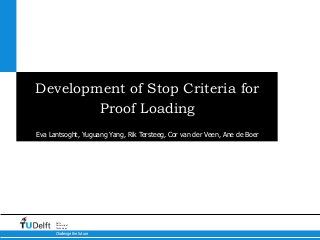Development of Stop Criteria for Proof Loading
Proof loading of bridges is an option to study existing bridges when crucial information is lacking. When proof loading is chosen, the question arises which maximum load should be attained during the test to demonstrate sufficient capacity, and which criteria, the “stop criteria”, based on the measurements during the test, would indicate that the test needs to be aborted before reaching the maximum desired load. A review of the literature identifies the stop criteria in currently used codes and guidelines. Beams sawn from the Ruytenschildt bridge were tested in a controlled way in the laboratory and analyzed with regard to the stop criteria from the literature. Recommendations are given for the future development of stop criteria for flexure and shear. These recommendations will form the basis for a guideline on proof loading of existing concrete bridges that is under development in The Netherlands.

Recomendados
Recomendados
Más contenido relacionado
Más de Eva Lantsoght
Más de Eva Lantsoght (20)
Último
Último (20)
Development of Stop Criteria for Proof Loading
- 1. Challenge the future Delft University of Technology Development of Stop Criteria for Proof Loading Eva Lantsoght, Yuguang Yang, Rik Tersteeg, Cor van der Veen, Ane de Boer
- 2. 2Development of Stop Criteria for Proof Loading Overview • Introduction • Why proof loading? • Stop criteria? • Overview of existing guidelines • Lab testing for analysis • Recommendations • Summary and conclusions Slab shear experiments, TU Delft
- 3. 3Development of Stop Criteria for Proof Loading Why load testing? (1) Bridges from 60s and 70s The Hague in 1959 Increased live loads common heavy and long truck (600 kN) End of service life + larger loads
- 4. 4Development of Stop Criteria for Proof Loading Why load testing? (2)
- 5. 5Development of Stop Criteria for Proof Loading Stop criteria • Safety philosophy • Stop criteria: • Further loading not permitted • Failure near • Irreversible damage near MSc Thesis W. Vos
- 6. 6Development of Stop Criteria for Proof Loading Proof load testing of bridges • Apply predetermined load to bridge • Information lacking • Damage due to ASR, … • Proof load testing • Immediate approval of bridge • Recalculate updated β
- 7. 7Development of Stop Criteria for Proof Loading Existing Guidelines for proof loading • Europe: DAfStB Richtlinie • Stop criteria • Concrete strain • Steel strain • Crack width and residual crack width • Residual deflection • For flexure • Structures with large existing cracking?
- 8. 8Development of Stop Criteria for Proof Loading Existing Guidelines for proof loading • North America: • Buildings: ACI 437.2M-13 • Bridges: Manual of Bridge Rating Through Load Testing (1998) • ACI 437.2M-13 stop criteria: • Residual deflection • Permanency ratio • Deviation from Linearity Index
- 9. 9Development of Stop Criteria for Proof Loading Research need • Guideline for proof loading of existing bridges for the Netherlands • Flexure + shear • Stop criteria?
- 10. 10Development of Stop Criteria for Proof Loading Lab testing for analysis (1) • Beams from Ruytenschildt Bridge • Cyclic loading protocol • Tests: Failure in shear and flexure • Measurements: • Lasers: deflection of beam • LVDTs: crack opening • Acoustic emission sensors Beams RSB01 after failure (Yang, 2015) Yang, Y. (2015). "Experimental Studies on the Structural Behaviours of Beams from Ruytenschildt Bridge," Stevin Report 25.5-15-09, Delft University of Technology, Delft, 76 pp. Beams RSB02B after failure (Yang, 2015)
- 11. 11Development of Stop Criteria for Proof Loading Lab testing for analysis (2) RSB 01F 02A 02B 03F 03A d (mm) 503 515.5 520 521 515 Ac (m2) 0.290 0.297 0.307 0.596 0.537 Rebar 4Ø22 4Ø19 4Ø22 4Ø19 4Ø22 5Ø19 9Ø22 8Ø19 7Ø22 8Ø19 ρl 0.91% 0.89% 0.96% 0.95% 0.92%
- 12. 12Development of Stop Criteria for Proof Loading Lab Testing for analysis (2) • Analysis of stop criteria ACI 437.2M-13 and DAfStB Richtlinie for RSB03F – Flexure test ACI 437.2M-13 Criterion Load (kN) DAfStB Criterion Load (kN) Δr 340 Δr 150 Ipr >Pu w new crack 300 IDL 250 Strain - PACI,st 250 PDA,st 150 Pu 606.6 Pu 606.6 PACI,st/Pu 0.41 PDA,st/Pu 0.25 Tersteeg, R. H. D. (2015). "Proefbelastingen op betonnen bruggen," B.Sc. Thesis, Delft University of Technology, Delft, The Netherlands, pp. 69.
- 13. 13Development of Stop Criteria for Proof Loading Lab Testing for analysis (3) • Analysis of stop criteria ACI 437.2M-13 and DAfStB Richtlinie for RSB03A – Shear test ACI 437.2M-13 Criterion Load (kN) DAfStB Criterion Load (kN) Δr >Pu Δr >Pu Ipr >Pu w new crack 690 IDL 390 Strain - PACI,st 390 PDA,st 690 Pu 706.7 Pu 706.7 PACI,st/Pu 0.55 PDA,st/Pu 0.98 Tersteeg, R. H. D. (2015). "Proefbelastingen op betonnen bruggen," B.Sc. Thesis, Delft University of Technology, Delft, The Netherlands, pp. 69.
- 14. 14Development of Stop Criteria for Proof Loading Recommendations • Use cyclic load protocol • Study linearity and repeatability of results • Flexure: Stop criteria exceeded long before failure • Suitable stop criteria • Crack width criterion from DAfStB + add lower bound • Residual deflection DAfStB / ACI 437.2M-13 + minimum load level • Deviation from Linearity ACI 437.2M-13: consistent performance except for retested beam • BUT: Deviation from Linearity and Permanency Ratio depend on applied loading protocol • Shear: • Need to develop stop criteria • Research on acoustic emission measurements
- 15. 15Development of Stop Criteria for Proof Loading Summary and conclusions • Proof loading to approve existing bridges • Existing guidelines: • Only flexure • Cracked structures? • Development of stop criteria for Dutch Guideline • Laboratory experiments • Check existing stop criteria • Stop criteria • Available for flexure • Adaptations for bridges needed • Current research: shear Viaduct Zijlweg, tested in summer 2015
- 16. 16Development of Stop Criteria for Proof Loading Contact: Eva Lantsoght E.O.L.Lantsoght@tudelft.nl // elantsoght@usfq.edu.ec +31(0)152787449
